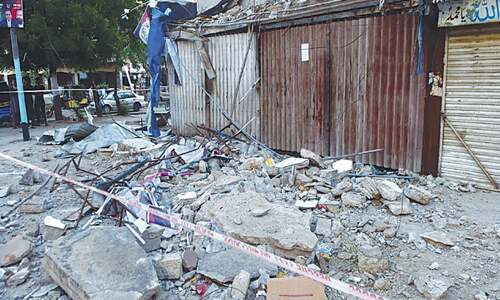
If you are not fond of traveling by train and you still want to reach this small railway station constructed by the British at least a century ago on your four-wheeler or on foot, then brace yourself for facing all kinds of difficulties. It requires guts, determination, sharp navigational skills and the will to go round and round in circles before even getting close to the station.
After all, these days Karachi’s Landhi area is not readily accessible to everyone.
Those who dare, reap the fruits of courage.
Those who don’t, think of Landhi as a remote part of the city where people somehow survive the daily challenges of life.
Landhi junction is not an ostentatious sight.
It is no insignificant place either.
It depends how you view your past and how you would like to restore some part of it.
If you value days gone by, the junction can provide you with a strange kind of solace.
If not, then no worries.
Forget it.
First things first, though.
Let’s try and find out where exactly the station is.
There are two ways of reaching Landhi railway station: one, by passing through the Korangi area (not recommended owing to the volatility that the locality is nowadays known for) and the other, which is less convoluted perhaps, is by enjoying the bumps and cracks of the National Highway.
So the latter is the fairer option.
Once you cross the Malir vicinity and enter Landhi’s jurisdiction, turn right from where an imposing overhead bridge leads to Korangi.
Do not go up the ramp.
Instead, take the extremely narrow service lane flanked by flea market shops.
Do not ask for directions otherwise you might end up taking a few rounds of the bridge and go dizzy.
Enjoy the insular road’s up-and-down ride and take the first turn left.
Lo and behold! You are in a different world altogether.
Well, not exactly.
But yes quite different from what you have been so far witnessing in the form of terribly maintained concrete flats on the main road.
This is the beginning of a not-so-big railway colony which will immediately remind you of the good old days.
The sloping roofs of stone-built quarters are the first sign of it.
And a little further into the colony, to the right, lies Landhi junction — a miniature building, in a manner of speaking, canopied by a pedestrian bridge.
The most striking feature of the station’s stone structure is its round arches.
The facade has bigger arches whereas the back of the building has smaller ones, covering the windows.
The station master’s room and the room adjoining it are not spacious but have enough space to accommodate the necessary machinery, including the magneto phone — the black version that you have often seen in the 1950s and ‘60s Pakistani and Indian films.
The furniture looks old, too.
For some reason, apart from mentioning the junction’s name in three languages — Urdu, Sindhi and English — the top of the entrance to the building also mentions how high the building is from sea level.
Interesting, isn’t it?
Noor Hasan is the station master at Landhi junction.
He was posted here a little less than a month back.
He says, “We have a department which sees to it that the maintenance of the building is done properly.
Every train that comes into or goes out of Karachi passes through this station so we have to be well organised.”
His colleague, Nazir, claims that the wooden doors and the furniture in the room are as old as the building.
The wood used in the furniture, according to him, is deodar.
As far as the track is concerned, a small stretch of it, which runs along the junction, was laid six or seven years back.
Architect Arif Hasan says, “In colonial times, engineers not architects used to make railway stations. The British had had some handbooks in which details and proportions of classical architecture were given. Whoever designed the railway station would consult those handbooks. It had classical details such as that of the cornices etc. The engineer’s job was to put all those things together”.
“When the British started constructing these buildings there was no electricity so climate was a major factor. The verandas used to be built towards the west side so that rooms remained cool. As for the furniture, I think it used to be of Burma teak not deodar. If it’s dark in colour it’s Burma teak,” says Mr Hasan.
As a KP-bound train zips past Landhi junction, perhaps it’s also time for this column to bid farewell.
It’s been almost four years since Karachi’s old buildings found a new admirer.
The column may not last, the admiration will.













































